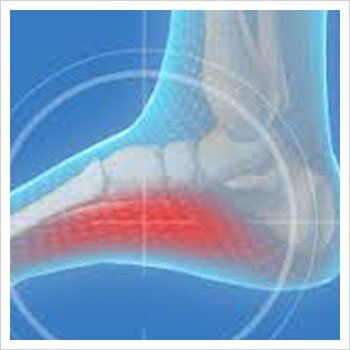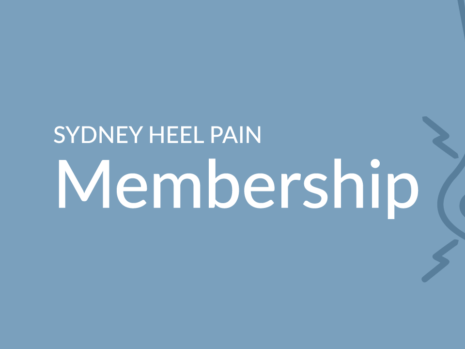ARCH PAIN
Arch pain can be the result of one or a combination of conditions that develop in the sole of the foot. Patients will often describe a tightness, pulling, strain, burning or ripping sensation through the mid arch of the foot, in front of the heel but behind the ball of the foot.
The pain in the arch can come on suddenly as in a one off day of increased walking or a sporting event, or progressively over a period of time as in walking in inappropriate shoes. Arch pain can be present every day and can be consistently present, in that it interferes with day to day activity. It will often feel worse in bare feet or thongs or flat and flimsy shoes such as ballet flats. In extreme cases the pain can be excruciating and can cause burning and throbbing in bed at night. The soft tissue in the arch can be torn and this can be detected via ultra sound or MRI.

CONDITIONS CAUSING ARCH PAIN
- Plantar Fasciitis
- Peroneal Tendonitis
- Tibialis Posterior Tendonitis
DO YOU HAVE BURNING ARCH PAIN IN YOUR FOOT?
Discover this leading Podiatrist’s exciting new approach to arch pain treatment, for Plantar Fasciitis, by reading this un-missable article here. CLICK
ARCH PAIN TREATMENT
It is important to assess and diagnose which part of the foot is affected and causing the pain. Physical examination is usually sufficient but in complex cases the patient can be referred for ultra sound imaging. An MRI is not usually necessary.
It is also important to determine whether or not the ligament, fascia or tendon has been torn as this will determine which treatment path to take. If the tissue is not torn, then it is important to determine what has caused the condition so that these contributing factors can be resolved. Factors such as footwear, exercise or even stretching techniques are common contributing factors.
If there are bio mechanical issues affecting the patients foot then these need to be addressed also. Orthotics can be arranged and shoes can be changed. Strapping can be applied to the foot and in extreme cases an immobilisation boot can be used.
Shock wave therapy can applied to the foot which can stimulate blood flow and accelerate healing in addition to relieving pain. Correct stretching techniques must be instructed and followed.
IN CLINIC – ARCH PAIN TREATMENT OPTIONS
- Strapping
- Orthotics where necessary
- Footwear changes
- Shock wave therapy
- Stretching
- Immobilisation boot
*IMPORTANT INFORMATION* IF YOU ARE NOT IN SYDNEY, AUSTRALIA AND YOU HAVE ARCH PAIN IN YOUR FOOT
Discover this leading Podiatrist’s exciting new approach to arch pain treatment, for Plantar Fasciitis, by reading this un-missable article here. CLICK
CASE STUDY – ARCH PAIN WITH WEIGHT GAIN BY KARL LOCKETT, SPORTS PODIATRIST
HISTORY – ARCH PAIN
A 44-year-old lady presents to the clinic with arch pain in her right foot which came on gradually. She reports an increase in body weight, gaining 14 kilo’s in approximately 6 months. The arch pain started 3months ago, around the time she was starting to feel her body weight was becoming a problem. Mrs X had been through an extremely stressful period at work and this meant she stopped visiting the gym. Her eating habits also became an issue and this compounded the weight gain problem. As her body weight increased she became aware of a mild arch pain and some general fatigue in her foot muscles. She would release the stiffness in her feet with a spiky ball at home and this provided temporary relief. In addition to the onset of arch pain and fatigue, she felt her calf muscles tightening and she would occasionally experience cramps, particularly in the evenings. Mrs X described the pain as a burning sensation under the sole of her foot and a sharp pulling sensation. She would often stop mid stride, and stand still, as the stabbing pain was extreme and she felt like her arch was tearing. One week ago, she went to see her regular physiotherapist who applied some rigid sports tape to her foot, and this provided short term relief.
HER ARCH PAIN WAS WORSE IN FLAT SHOES
Mrs X brought a large selection of shoes to her consultation and wondered if her arch pain and general foot fatigue was due to her choice of footwear. Amongst the collection were 3 pairs of ballet flats, a pair of Merrell street shoes, and some flat and flexible office shoes. Not one pair of her shoes had mid sole support or a small heel. The uppers were soft and flexible and also lacked support.
Mrs X did have a pair of Asics sports shoes too, although she did not bring these along to the consultation, as she had not worn them for some 6 months at the gym. On the odd occasion that she did wear the Asics running shoes she explained that her arch pain would subside and she could spend longer on her feet. This allowed her to carry out some household chores and go for an occasional walk without too much discomfort.
HER ARCH PAIN WAS DUE TO PLANTAR FASCIITIS
Mrs X was referred to the imaging centre for an Ultra sound scan of her painful foot. She was relieved when the report explained the cause of her arch pain, describing inflamed Plantar Fascia – a condition commonly known as Plantar Fasciitis. Plantar Fasciitis can cause pain in the heel and the arch of the foot and is common in people carrying extra body weight. The Sports Podiatrist reassured Mrs X that Plantar Fasciitis was a common condition that was treatable, and that she would make a full recovery within a month or 2, once treatment commenced.
PHYSICAL EXAMINATION OF ARCH PAIN
The medical report from the imaging centre had already described Plantar Fasciitis as the cause of this lady’s arch pain and the physical examination revealed typical findings. There was pain on palpation of the Plantar Fascia, distal to the heel and along the medial slip. Her peroneal tendons were unremarkable and there was no heel pain. Mrs X was able to walk in her bare feet without limping, but was unable to perform a single leg heel raise without pain. This is typical in patients with arch pain as the exercise loads the Plantar Fascia and pulls through the arch.
FACTORS CAUSING THE ARCH PAIN IN MRS X
The increase in body weight was clearly a contributing factor in the onset of Mrs X’s arch pain. The weight gain adds load to the feet and causes stress and strain on muscles and tendons. When the weight gain occurs quickly, the feet don’t always cope with the extra stress and the Plantar Fascia can become overloaded. This leads to the micro tearing and inflammation of the Plantar Fascial fibres.
In addition to this, the extra body weight leads to an increase in calf muscle bulk and tightness. This muscle group works harder during stance and push-off in heavier patient’s. The stiffness in these muscles, which are attached to the back of the heel, causes a stronger pulling action on the back of the foot. This in turn causes a stronger pull through the sole of the foot, which can lead to strain in the Plantar Fascia and result in arch pain.
There’s a fairly good case that would suggest Mrs X would not have developed this acute arch pain had she worn more supportive shoes. Ballet flats, and any shoes that are flat and flexible are likely to cause problems in heavier patient’s, if used for longer periods.
TREATMENT OF MRS X ARCH PAIN
It was explained to Mrs X that she needed to lose weight in order to help her fatigued feet and reduce this chronic and acute arch pain. She was already aware of this and explained she can’t walk for exercise, to burn the calories. She was advised to swim and perform resistance training for her upper body. Mrs X enquired about the use of prescription orthotics. She felt her feet were more unstable since gaining weight. The Sports Podiatrist
explained to Mrs X that the orthotics were a valid treatment option, and that the Carbon Fibre material would be the preferred choice. These are a firm material but are streamlined and less bulky, and so fit into more shoes more easily. They would have slow release poron to provide cushioning and the support from these orthotics would reduce the strain on the whole foot, particularly the arch. This would allow the arch pain to resolve over time, as the micro tears and inflammation subsided.
FOOTWEAR CHANGES
A comprehensive list of appropriate shoes that would offer support and accommodate the orthotics was given to Mrs X. These were tailored to her foot type and body weight. Work shoes, casual shoes and trainers were all recommended.
OTHER
As a temporary measure, rigid sports tape was applied to both feet and this would be used until the orthotics were ready for fitting. Calf massage was also recommended and a comprehensive stretching programme was applied.
2 WEEKS ON
After 2 weeks, Mrs X returned to be fitted with her orthotics. Her pain level had not changed when the arches were palpated. However, she did feel more stable and slightly more comfortable with the strapping in place, and the new shoes on her feet.
6 WEEKS ON
Calf range had improved and pain had reduced by 40%. Mrs X was compliant with stretching but was not applying ice packs to her feet on a daily basis. Her orthotics were very comfortable and were helping. She wore them every day. She had lost 2.5 Ks in weight, partly due to dietary changes and partly due to swimming.
10 WEEKS ON – MINIMAL ARCH PAIN
Mrs X reported that her arch pain had virtually gone. There was some mild discomfort if she was standing still, without walking, for extended periods, as she had recently done at a work conference. However, she was very comfortable and free from pain at all other times. When palpating her arches, she did not flinch and reported mild tenderness but to pain.
Mrs X was asked to continue her change in eating habits but to now introduce walking. 3 k’s to commence and only twice a week. Her stretching must continue and her training programme would be modified in due course, increasing gradually.
PLEASE NOTE: The information in this case study is specific to one individual patient and should not be taken as general advice. If you have arch pain or a condition causing discomfort in your feet, you should seek the help of a Sports Podiatrist.
***Discover this leading Podiatrist’s exciting new approach to arch pain treatment, for Plantar Fasciitis, by reading this un-missable article here. CLICK ***
For Plantar Fasciitis information, click here: Plantar Fasciitis





